[Cabinet of Fashion Excerpts from Lady's Monthly Museum]. London: [Published by Vernor & Hood], 1798-1803.
I'll admit when I first looked at this book I had no idea what it was. It had none of the typical hallmarks we've come to expect from our books. No title or title page, no publication or copyright information, and the contents were an assortment of pages of text and coloured plates. From clues such as the running title at the top of the page, and the name of the repeating segment ("Cabinet of Fashion") led me to Lady's Monthly Museum.
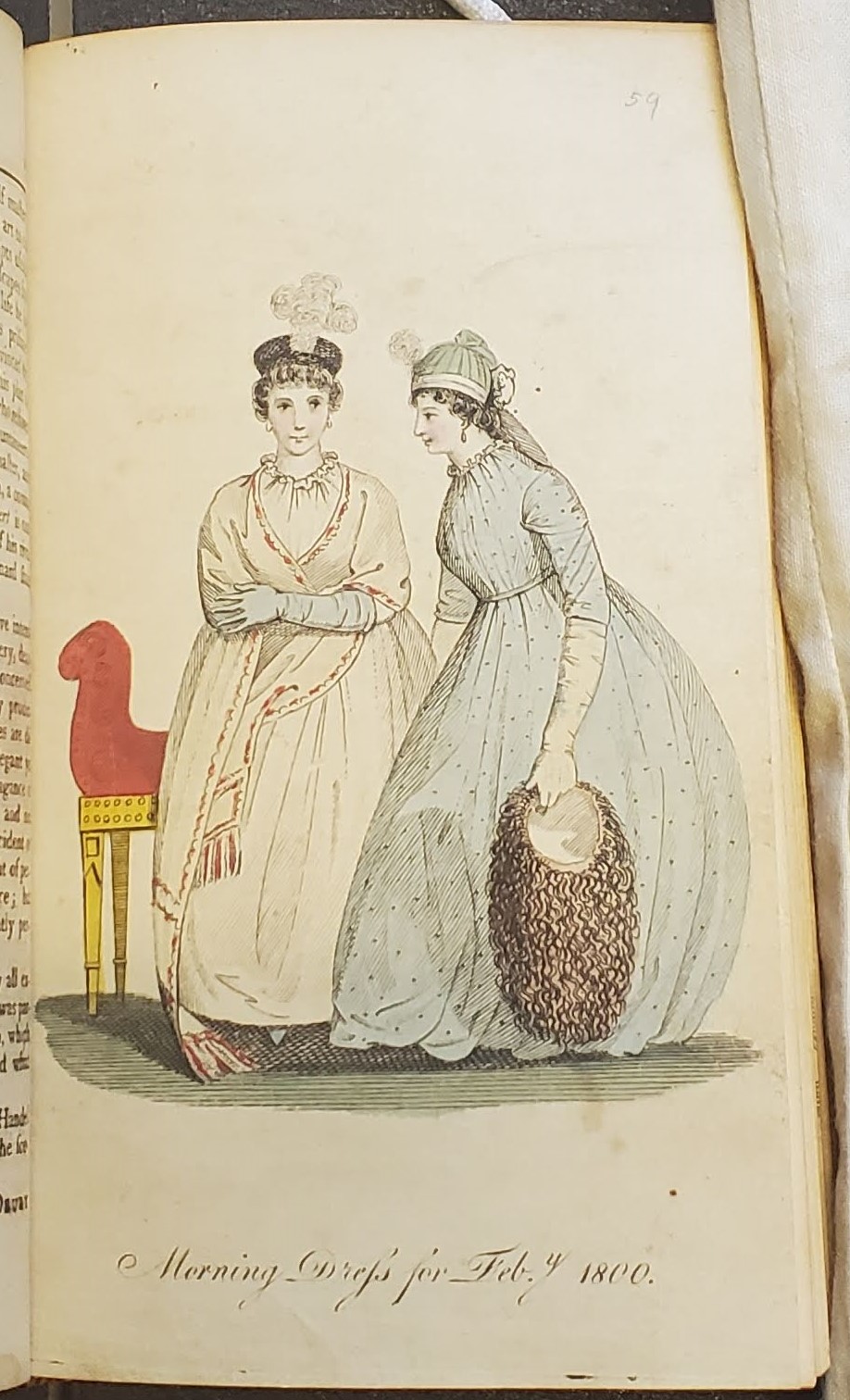 For much of the late 18th and early 19th centuries the market for women's magazine was dominated by The Lady's Magazine which featured a variety of genres including fiction, poetry, biographies, embroidery patterns, song sheets, travel writing, and works on medicine, history, science, law, and politics. However, beginning in 1798 a new periodical emerged as an important rival, Lady's Monthly Museum. This occurred despite the fact that Museum was smaller in size and length and more expensive than Lady's Magazine. The reason was Museum's inclusion of a monthly fashion feature "Cabinet of Fashion" which included coloured plates of the current fashions from London and Paris. This innovation made Museum a popular choice for readers, so much so that it spurred Lady's Magazine to publish its own fashion plates, with an increase in price. The competition between the two periodicals remained and was oftentimes tense, largely due to their significant overlap in readers, before the publications eventually merged in 1828.
For much of the late 18th and early 19th centuries the market for women's magazine was dominated by The Lady's Magazine which featured a variety of genres including fiction, poetry, biographies, embroidery patterns, song sheets, travel writing, and works on medicine, history, science, law, and politics. However, beginning in 1798 a new periodical emerged as an important rival, Lady's Monthly Museum. This occurred despite the fact that Museum was smaller in size and length and more expensive than Lady's Magazine. The reason was Museum's inclusion of a monthly fashion feature "Cabinet of Fashion" which included coloured plates of the current fashions from London and Paris. This innovation made Museum a popular choice for readers, so much so that it spurred Lady's Magazine to publish its own fashion plates, with an increase in price. The competition between the two periodicals remained and was oftentimes tense, largely due to their significant overlap in readers, before the publications eventually merged in 1828.
Having identified the work from which this book derived, next was to determine the date range of the plates and how to describe the item at hand. The plates in the volume start with Museum's first volume from July 1798 and have the plates from each monthly edition of the magazine up to June 1803. With the dates established, next was a name. In cataloguing, when the information required is not available on the item being examined, it can be found elsewhere. In these cases the information is given in square brackets to indicated that it was supplied by the cataloguer. In this case, even the title had to be supplied by the cataloguer. This is because if the title was simply Lady's Monthly Museum, it would imply that the book at hand is a complete copy of the magazine. Instead a title needed to be devised that accurately reflects the item, [Cabinet of Fashion excerpts from Lady's Monthly Museum].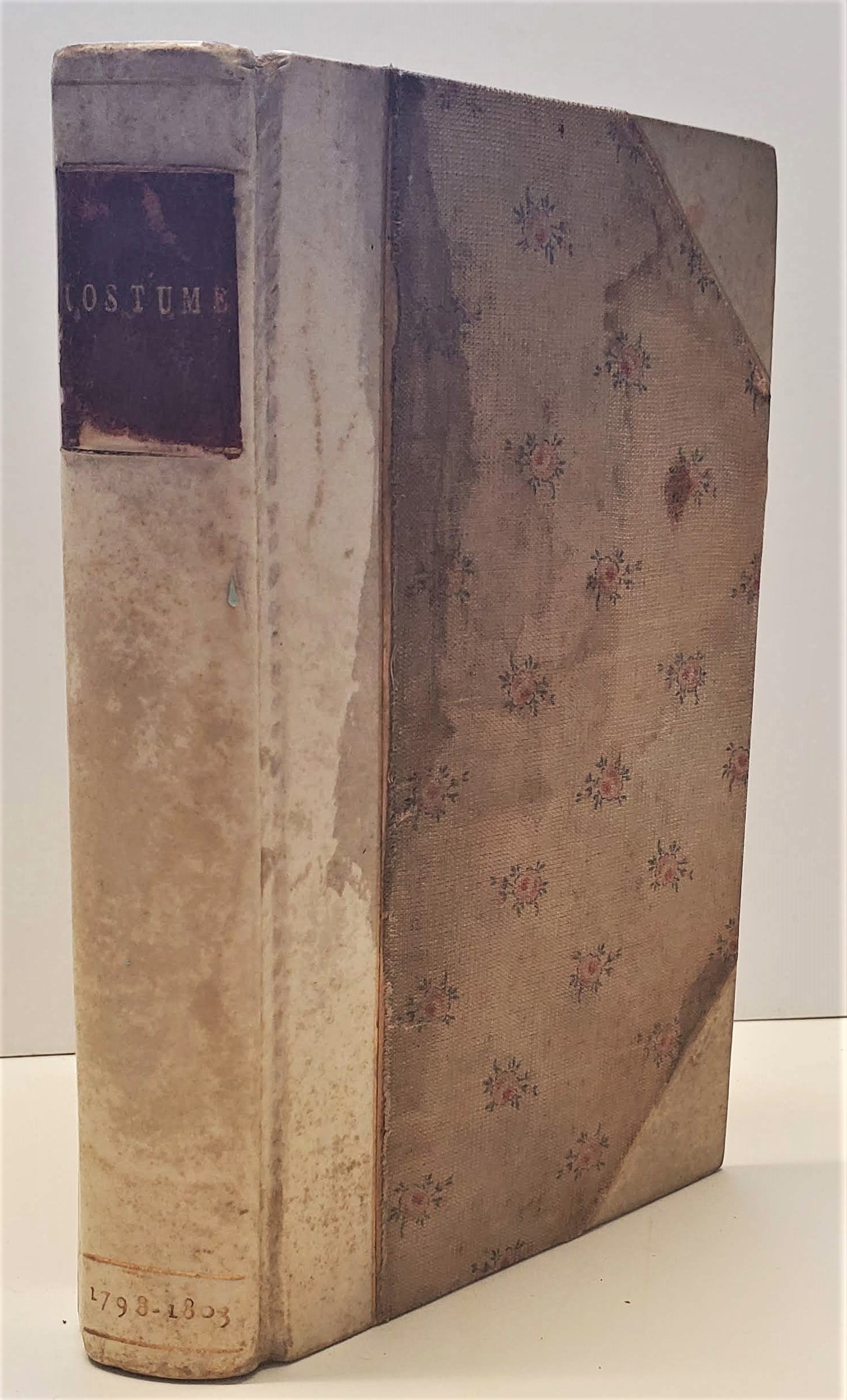
Perhaps the next question is why. Why would someone have the plates from a monthly magazine removed then bound together in a single volume? While this question is not completely answerable (we cannot ask the former owner), assuming the book was bound around the time the periodical was published, there are some explanations as to how this could have happened easily in the early 19th century. First, illustrations were and continue to be popular among potential buyers, owners, and collectors. They are often seen as the most valuable part of a book, and are frequently missing from antiquarian books due to past removal. They are also still subject to theft today. It is therefore plausible that someone would prize these colourful illustrations so much to collect and bind them together. During this period that was easy to do. The early 19th century was the end of the Hand Press Period, when books were bound after they were bought. This meant that illustrations could have easily been removed before binding, or removed and collected with the rest discarded. It also meant that finding someone to bind the book was a relatively simple task, there were hundreds of binders operating in Great Britain in the early 1800s. From there the patron was free to choose a binding based on their taste and budget. In this case the owner chose a half vellum binding with a flower patterned cloth. A red leather spine label completes the binding with the past owner's own title for the work, Costume.
Record: 18682
Tuer, Andrew White. History of the Horn-book. [Special edition]. London: The Leadenhall Press, Ltd., 50 Leadenhall Street, E.C., 1896.
Teaching children the alphabet is the foundation of literacy, and we have featured alphabet books on this blog before, but there was another type of teaching tool which became popular towards the end of the sixteenth century, the horn-book. A horn-book was a leaf with a written or printed alphabet, also usually accompanied by nine digits, a syllabary, and the Lord's Prayer, affixed to a board or piece of wood with a handle. Finally, the paper was covered with a thin piece of transparent horn (attached with brass) to prevent damage, hence the name. Gradually, the use of horn became inconsequential, and horn-book began to refer to any alphabet tablet. They could be elaborate and heavily decorated with silver or gold, backed with decorated leather, or churned out in great quantities made of rough, uneven wood with horn sticking beyond the brass meant to secure it in place. Surviving examples of horn-books are rare, and what commonly remains in the material record are well-made horn-books with sanded wood and impressed leather.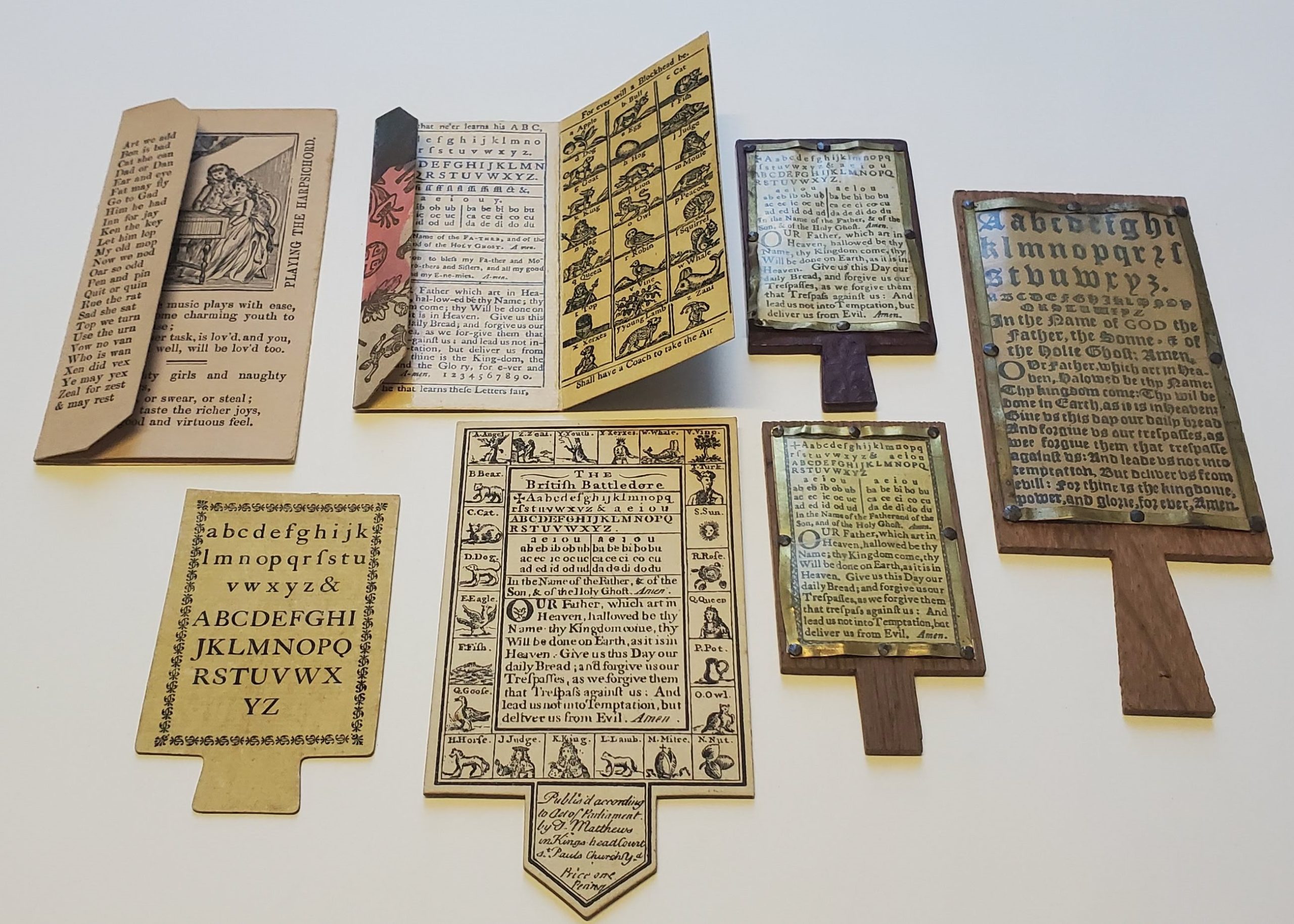
Horn-books were eventually made of cardboard, but fell out of fashion in the 19th century as many other teaching tools came into use, such as the battledore. A battledore was so named because after students used it for lessons, they played the game of battledore and shuttlecock with them, an early form of badminton. The original association between battledores and the alphabet came when the alphabet was painted or impressed onto wooden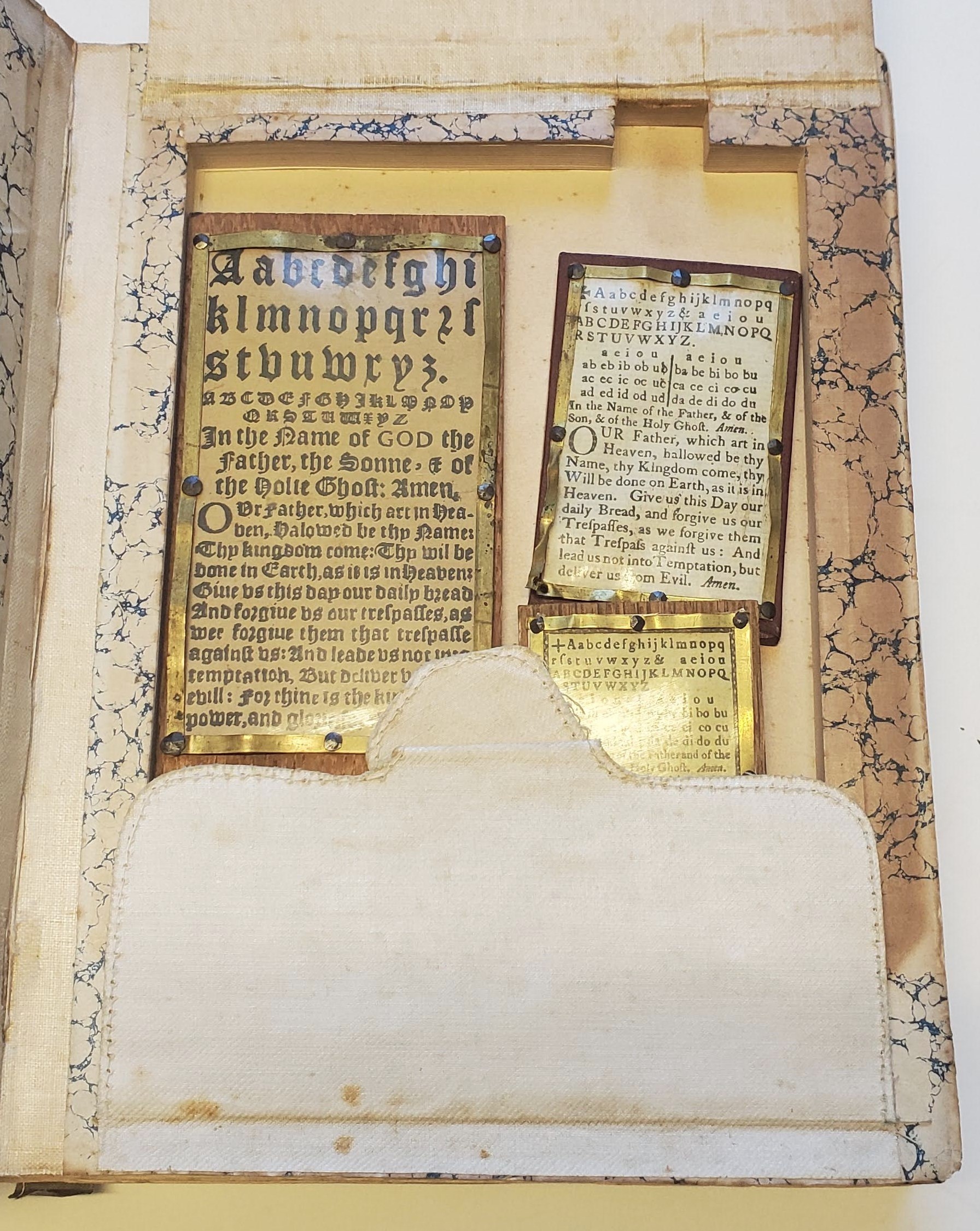 battledores used for the game, but in time battledore also came to mean a printed piece of cardboard with much the same information on it as a horn-book. To still endure its use as a racket, battledores were printed on a double fold of stiff card with an extra flap on one edge to fold like a pocketbook. Both the battledore and horn-book would be supplanted by the ever-present alphabet book, also known as an abecedarium.
battledores used for the game, but in time battledore also came to mean a printed piece of cardboard with much the same information on it as a horn-book. To still endure its use as a racket, battledores were printed on a double fold of stiff card with an extra flap on one edge to fold like a pocketbook. Both the battledore and horn-book would be supplanted by the ever-present alphabet book, also known as an abecedarium.
This new ASC acquisition describes horn-books in detail, as well as provides several replica examples of horn-books and battledores described in the book. They are contained in a hollowed-out portion at the beginning of each volume. In it include examples of simple horn-books, a more ornate horn-book with an impressed leather backing, cardboard horn-books, and examples of the later battledore.
Record: CLC 2850
Works of Geoffrey Chaucer
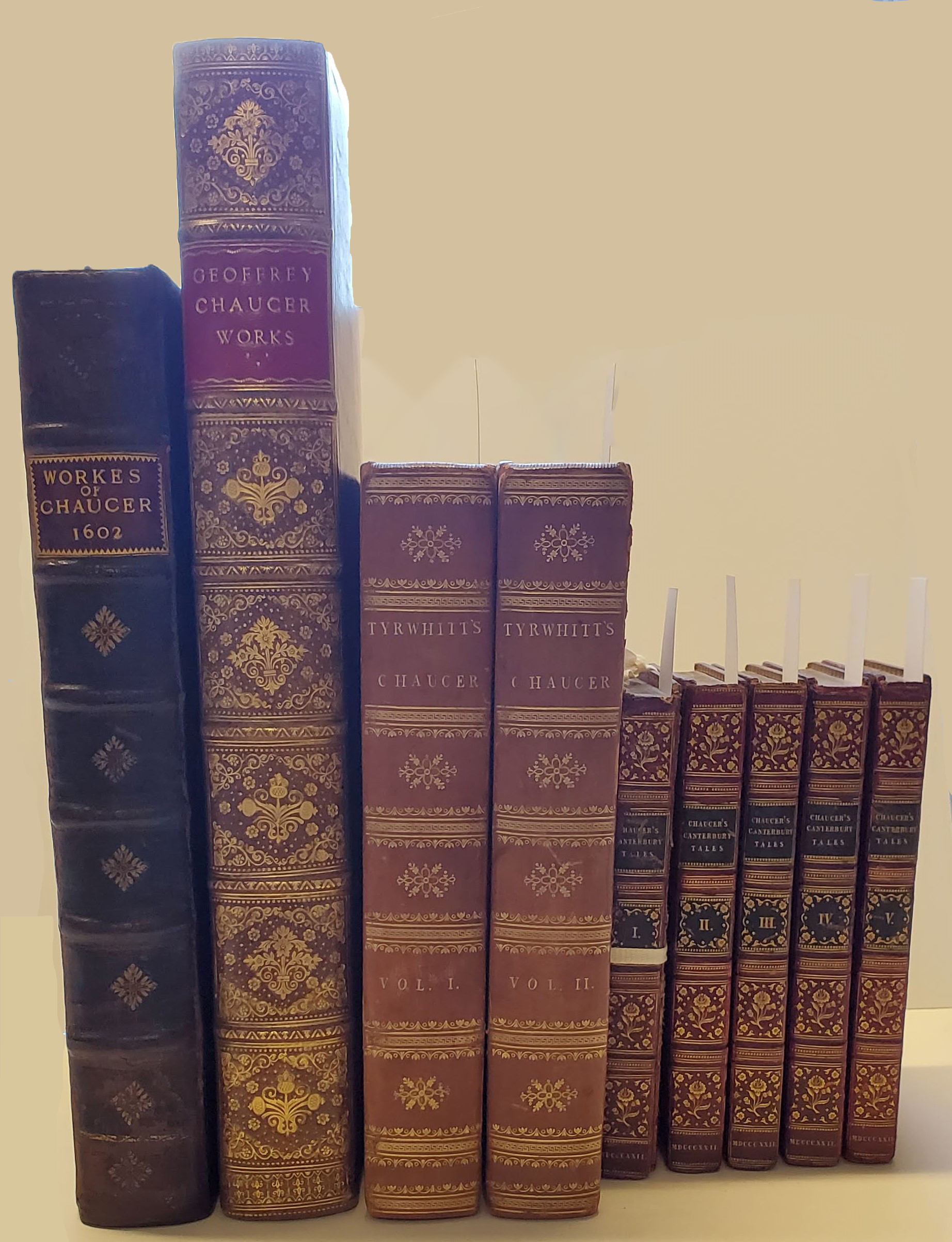 The importance of Geoffrey Chaucer to English poetry and prose cannot be overstated. Born in the mid-fourteenth century Chaucer was not only the writer of The Book of the Duchess, Troilus and Criseyde, and The Canterbury Tales, he was a diplomat, courtier, solider, and public servant. His works were some of the first to be printed in English by William Caxton, and have remained in print ever since. People have devoted their entire careers to the study of Geoffrey Chaucer and his works, and it would be impossible in these short paragraphs to do that work justice. However with these four new ASC acquisitions I hope to highlight different editions of Chaucer, and the editors that made them.
The importance of Geoffrey Chaucer to English poetry and prose cannot be overstated. Born in the mid-fourteenth century Chaucer was not only the writer of The Book of the Duchess, Troilus and Criseyde, and The Canterbury Tales, he was a diplomat, courtier, solider, and public servant. His works were some of the first to be printed in English by William Caxton, and have remained in print ever since. People have devoted their entire careers to the study of Geoffrey Chaucer and his works, and it would be impossible in these short paragraphs to do that work justice. However with these four new ASC acquisitions I hope to highlight different editions of Chaucer, and the editors that made them.
ASC has acquired two different editions of Chaucer's complete works and two editions of his Canterbury Tales. These different editions vary in their translations, vocabulary, and paratexts (the material that surrounds the main text, frames it, and informs its interpretation) such as biographies, critical opinions, translations, poems, and glossaries. Even which works to include varies, as over time the works attributed to Chaucer has grown then shrunk, with earlier editions containing what would now be considered spurious or doubtful works such as The Plowman's Tale and The Floure and the Leafe. Having these different editions is important because just as Chaucer is studied, so too is the editorial history of Chaucer's works.
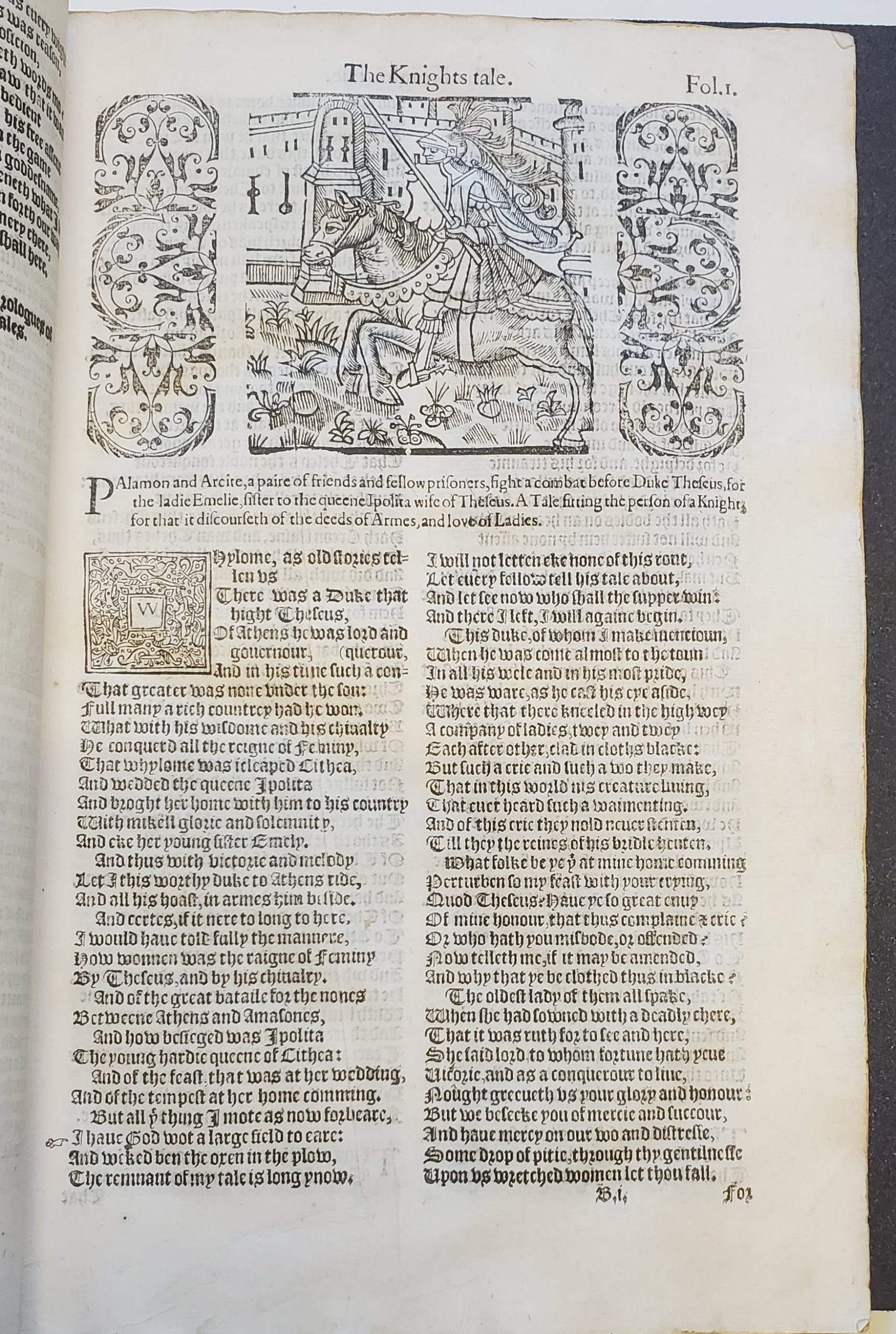
First page of "The Knights Tale" from Speght's 1602 edition.
The earliest work newly obtained by ASC is Thomas Speght's The Vvorkes of Our Ancient and Learned English Poet, Geffrey Chaucer, Newly Printed (1602).This work is the second Speght edition of Chaucer's works, the first being printed in 1598. Both these editions were the first to attempt thorough punctuation of Chaucer's works, and this edition is largely shaped by the revisions suggested by Francis Thynne in is 1599 letter Animaduersions uppon Annotacions and corrections of some imperfections of impressions of Chaucer's workes. It was Speght's Chaucer that remained popular throughout the Early Modern period and helped cement Chaucer as part of the English literary canon.
Speght based his publication on the earlier work of John Stow and William Thynne earlier in the 16th century, but Speght also added paratextual material as well as additional works attributed to Chaucer. In his 1598 edition Speght added The Isle of Ladies and The Floure and the Leafe, and in 1602 he added The ABC and The Tale of Jack Upland. Of these four, only The ABC remains attributed to Chaucer. The inclusion of multiple works by Chaucer in this and other editions was fueled by the desire at the time for textual completeness, and it was not until the late-eighteenth century that books were printed with a single work of Chaucer's.
Much study has been done on the paratextual material in Speght's Chaucer, what it says about Renaissance values, and how those values were transferred onto Chaucer. Speght describes a Chaucer who is a gentleman right out of the Renaissance, a decidedly English man who was educated all over the country, a Protestant man who studied with John Wycliffe. Speght emphasized Chaucer's tangential relationship to royalty and describes his active court life. However much of this information relies on rumour and speculation, especially with regards to his court life and his relationship to the Catholic Church. The fact that it relied on speculation did not stop the influence Speght's account of Chaucer's life had on future scholarship.
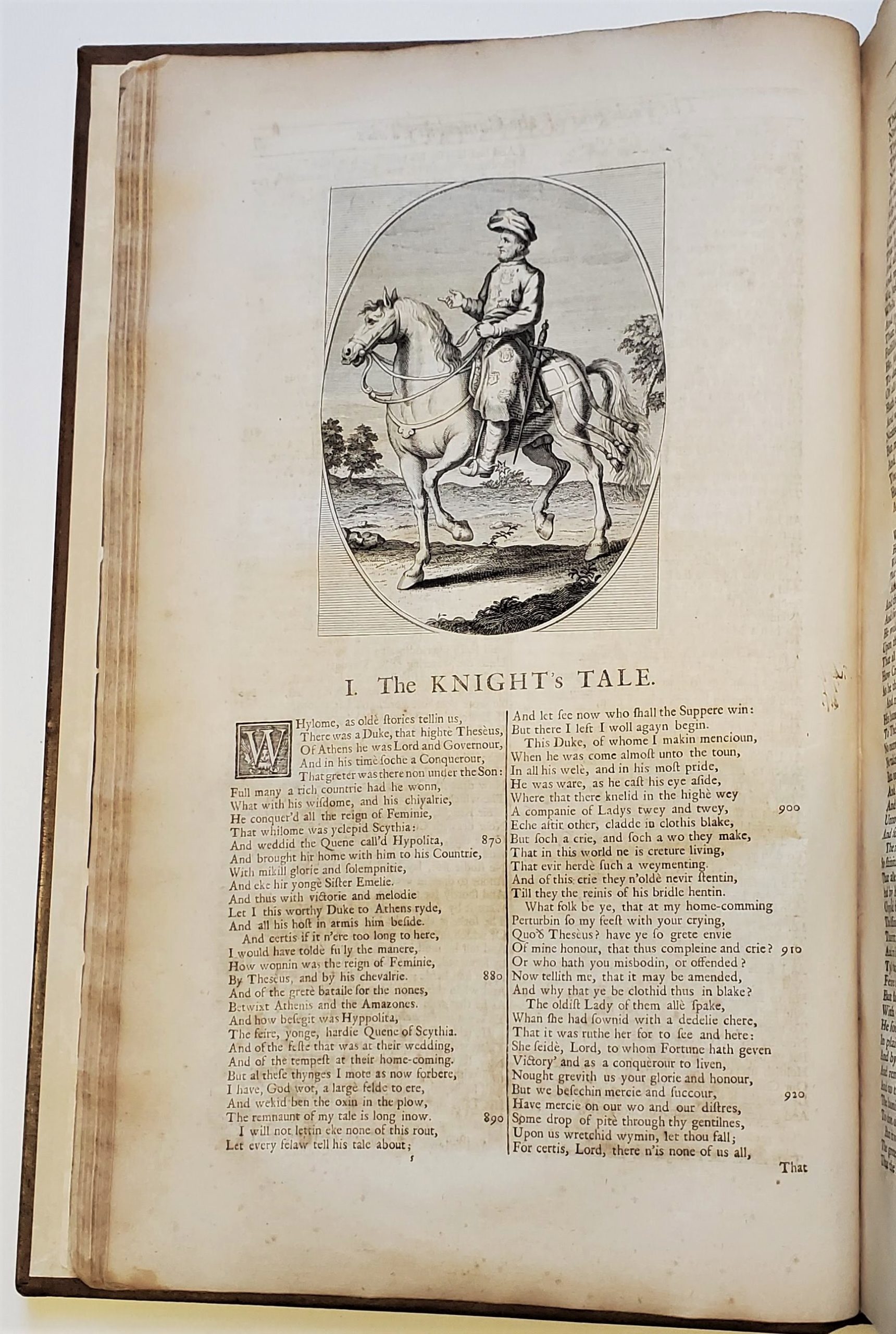
First page of "The Knight's Tale" from Urry's 1721 edition.
Other supplementary material in this volume remains significant outside the study of Chaucer. The glossary contained significant revisions between the 1598 and 1602 editions, while also increasing the number of entries by almost 30%. This glossary remained important for some time as the most extensive list of obsolete words for anyone trying to read Middle English. The significance of the Speght edition makes it an important work for both the study of Chaucer and the study of the history of English. In addition to the importance of single editions, having multiple editions of Chaucer allows for comparisons between them. The next edition acquired by ASC is a first edition of John Urry's The Works of Geoffrey Chaucer.
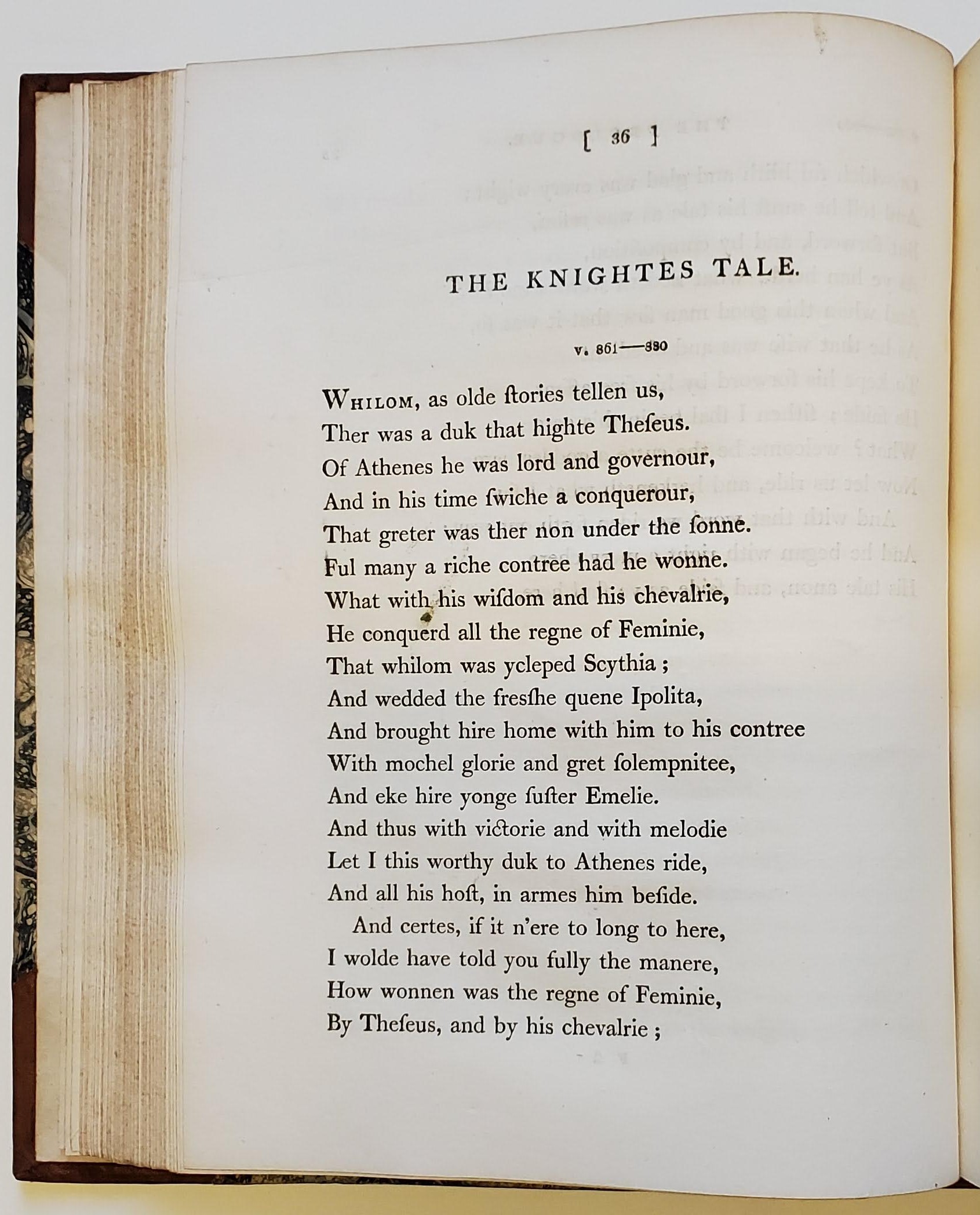
First page of "The Knightes Tale" from Tyrwhitt's second edition (1798).
Left unfinished after his death in 1715, John Urry's The Works of Geoffrey Chaucer was completed with a preface and glossary by William and Timothy Thomas and published in 1721. It was the first edition to be printed in Roman type, previously editions of the text were printed in Blackletter (Gothic) typeface. Urry was also the first in about a hundred and fifty years to consult multiple older manuscripts to inform his text, something not done since William Thynne in 1534. Despite these innovations, this edition was also subject to repeated criticisms due to the corrections Urry made in the name of conforming to a metre. He frequently added or omitted initial and final syllables, with the assumption that he was correcting the mistakes of past transcribers. Even in later Chaucer editions, such as Tyrwhitt's discussed below, Urry is criticized both for the changes he made and his choice of what to include.
As mentioned with Speght's 1602 edition, works of questionable attribution were often included in the works of Chaucer, and this trend reached its apex with John Urry's edition. In it, seventy one individual works are included, of which only about a third are now thought to be by Chaucer. Conversely, the last two editions ASC has acquired attempted to pare down the works of Chaucer.
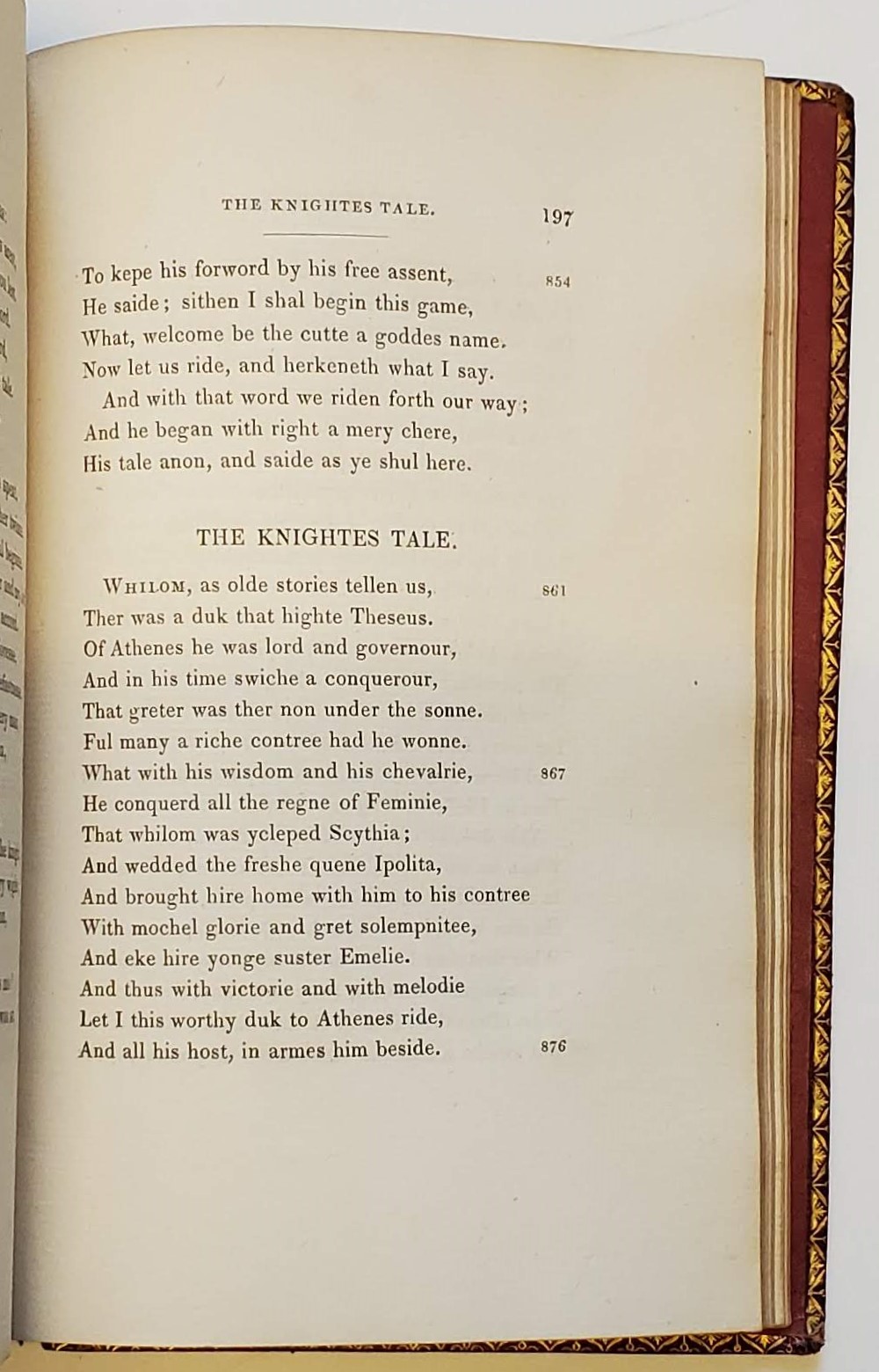
First page of "The Knightes Tale" from Tyrwhitt's 1822 edition.
Tyrwhitt's first published The Canterbury Tales in 1775 and broke with editorial tradition. Rather than print the entire canon like the previous five Chaucer editions (Urry and Speght included), Tyrwhitt printed only The Canterbury Tales. He also attempted to reduce the number of spurious works attributed to Chaucer through the examination of language and metre, doubtful that Chaucer had written them all. At the time Tyrwhitt received little recognition for his work, and it has not been without criticism. Tyrwhitt's work has received retrospective critiques for his method of consulting numerous manuscript sources and selecting the "best" readings from them and combining them into a single work. While the work may flow smoothly, the selection process assumed that all manuscripts were written at the same time with the same English, and means the text is heavily subjective. However, it must be remembered that Tyrwhitt's edition was created before the concept of a critical text began and it was still an enormous effort of consulting twenty-five manuscripts. ASC's newest Chaucer acquisitions include the second edition of Tyrwhitt's 1775 Canterbury Tales published in 1798, as well as a later five volume set printed in 1822. While each edition is not without its criticisms, they are still valuable tools in the study of Geoffrey Chaucer and how his works have changed depending on the time, the translation, and the editor.
Chaucer, Geoffrey and Thomas Speght. The Vvorkes of Our Ancient and Learned English Poet, Geffrey Chaucer, Newly Printed .... London: Printed by Adam Islip, 1602.
Record: 18672
Chaucer, Geoffrey, Timothy Thomas, and John Urry. The Workes of Geoffrey Chaucer: Compared with the Former Editions, and Many Valuable Mss: Out of which, Three Tales are Added Which Were Never Before Printed. Edited by Timothy Thomas and John Urry. London: Printed for Bernard Lintot, between the Temple Gates, 1721.
Record: 18673
Chaucer, Geoffrey and Thomas Tyrwhitt. The Canterbury Tales of Chaucer: to Which are Added an Essay on His Language and Versification, and an Introductory Discourse, Together with Notes and a Glossary. Edited by Thomas Tyrwhitt. The second edition. Oxford: At the Clarendon Press, 1798.
Record: 18674
Chaucer, Geoffrey and Thomas Tyrwhitt. The Canterbury Tales of Chaucer: With an Essay on His Language and Versification, an Introductory Discourse, Notes and a Glossary. Edited by Thomas Tyrwhitt. London: Printed for W. Pickering, 31 Lincoln's-Inn Fields, and R. and S. Prowett, 269 Strand, 1822.
Record: 18675
Written by Taylor Tryburski
References
Batchelor, Jennie. Lady's Magazine (1770-1832) and the Making of Literary History. Edinburgh: Edinburgh University Press, 2022.
Tuer, Andrew White. History of the Horn-book. [Special edition]. London: The Leadenhall Press, Ltd., 50 Leadenhall Street, E.C., 1896.
Machan, Tim William. "Speght's 'Works' and the Invention of Chaucer." Text 8 (1995): 145-70.
Carlyle, E.I., and A.S.G. Edwards. "Urry, John (1666-1715), literary editor." Oxford Dictionary of National Biography.
Hammond, Eleanor Prescott. Chaucer: a Bibliographical Manual. New York: P. Smith, 1933.

